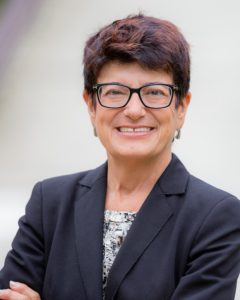A Conversation Between Carolyn C. Meltzer and Hossein Jadvar

Carolyn C Meltzer, MD – Dean of the Keck School of Medicine of USC – May S. and John H. Hooval, M.D., Dean’s Chair – Professor of Radiology (Photo: Richard Carrasco)
Hossein Jadvar, MD, PhD, MPH, MBA, a tenured professor in the Department of Radiology at the Keck School of Medicine of the University of Southern California (USC) in Los Angeles, talked with Carolyn C. Meltzer, MD, about her career in science and academic leadership. Dr. Meltzer became the Dean of the USC Keck School of Medicine and the John and May Hooval Dean’s Chair in Medicine on March 1, 2022. In this position, she oversees the operation and academic affairs of 26 basic and clinical academic departments and 16 major research institutes that sponsor training of more than 1,200 medical students, resident physicians, and graduate students in more than 70 specialty or subspecialty programs each year. She was recruited from Emory University School of Medicine (Atlanta, GA), where she served as the William P. Timmie Professor and Chair of Radiology and Imaging Sciences for 15 years. At Emory she also served as the Executive Associate Dean of Faculty Academic Advancement, Leadership, and Inclusion and as the Chief Diversity and Inclusion Officer. Dr. Meltzer has conducted research in multimodality imaging evaluation of neuropsychiatric disorders, Alzheimer disease, brain structure and function in normal aging, and cancer.
Dr. Jadvar: Could tell me about your career journey? What made you interested in a life of medicine and science, and what propelled you toward leadership in academic radiology?
Dr. Meltzer: I was always interested in science and math and was also a very visual person. Even early on, I played competitive chess, seeing the moves on the chessboard and always thinking about how to solve problems. As a teenager, I would often read about the brain. I was fascinated by behavior, mood, and the workings of the brain—and how little we knew. At college, I decided that I was interested in medical school. I couldn’t decide whether I wanted to be a neuroscientist or a physician. I spent a summer doing student research in Chicago, helping in a translational lab at Michael Reese Hospital (which closed in 2009). There, a distant relative invited me to her home for dinner. She and her husband were lovely people. It turned out that he was Robert N. Beck, who developed one of the first PET scanners at the University of Chicago. I had been reading about PET imaging and spent much of the evening asking about his work. He showed me scans that helped in understanding the inner workings of the brain. This was in the early days of functional imaging, and this moment was very influential in my life. When I went on to study at the Johns Hopkins Medical School, I volunteered as a control subject for a PET imaging study to make some money. This was one of the earliest such studies using a neuroreceptor tracer. I ended up working for these scientists and then spending another year on a PET research fellowship. These experiences fueled my excitement about brain imaging, particularly nuclear medicine and neuroradiology, which led me eventually to board certifications in both fields. (…Read More)